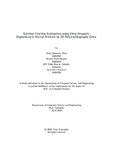| dc.contributor.advisor | Alam, Md. Golam Rabiul | |
| dc.contributor.author | Khan, Abde Musavvir | |
| dc.contributor.author | Shejuty, Myesha Farid | |
| dc.contributor.author | Talukder, MD. Nafis Shariar | |
| dc.contributor.author | Zubayear, Syed Ibna | |
| dc.date.accessioned | 2021-06-02T09:54:46Z | |
| dc.date.available | 2021-06-02T09:54:46Z | |
| dc.date.copyright | 2020 | |
| dc.date.issued | 2020-04 | |
| dc.identifier.other | ID: 16301119 | |
| dc.identifier.other | ID: 16301123 | |
| dc.identifier.other | ID: 16101134 | |
| dc.identifier.other | ID: 16301126 | |
| dc.identifier.uri | http://hdl.handle.net/10361/14469 | |
| dc.description | This thesis is submitted in partial fulfillment of the requirements for the degree of Bachelor of Science in Computer Science and Engineering, 2020. | en_US |
| dc.description | Cataloged from PDF version of thesis. | |
| dc.description | Includes bibliographical references (pages 34-35). | |
| dc.description.abstract | Ejection fraction value denotes how much blood is pumped out of the heart to different parts of the body. It is a routine clinical procedure in heart function assessment,
where the left ventricle of the heart has to be manually outlined by doctors in clinical settings to measure the EF value which is time consuming and highly varies by
observer. Modern day deep learning methods are able to automatically complete
this type of outlining task automatically with much ease and better efficiency even
when the model is trained on a deeper neural network and smaller dataset. This
paper investigates the deep semantic segmentation networks to find the most accurate one to implement an EF estimation system could be built on the most accurate
image segmentation network which will reduce the pressure off the doctors shoulders
and stop the eyeball estimation of EF values which is subject to inter-observer variability. This paper evaluated three different image segmentation neural networks
namely U-Net, ResUNet, Deep ResUNet to find their accuracy score basing mostly
on the dice accuracy metric. The most accurate model of the three Deep ResUNet
has been utilized to form Left Ventricle segmentation network for end systole and
end diastole images on which volume measurement formula is applied to find out
the Ejection Fraction value. | en_US |
| dc.description.statementofresponsibility | Abde Musavvir Khan | |
| dc.description.statementofresponsibility | Myesha Farid Shejuty | |
| dc.description.statementofresponsibility | MD. Nafis Shariar Talukder | |
| dc.description.statementofresponsibility | Syed Ibna Zubayear | |
| dc.format.extent | 35 Pages | |
| dc.language.iso | en_US | en_US |
| dc.publisher | Brac University | en_US |
| dc.rights | Brac University theses are protected by copyright. They may be viewed from this source for any purpose, but reproduction or distribution in any format is prohibited without written permission. | |
| dc.subject | Ejection fraction | en_US |
| dc.subject | Deep learning | en_US |
| dc.subject | ResUNet | en_US |
| dc.subject | 2D Echocardiography | en_US |
| dc.subject | Apical 4-Chamber (A4C) | en_US |
| dc.subject | Left ventricle | en_US |
| dc.subject | CNN | en_US |
| dc.subject | U-Net | en_US |
| dc.title | Ejection fraction estimation using deep semantic segmentation neural network on 2D Echocardiography data | en_US |
| dc.type | Thesis | en_US |
| dc.contributor.department | Department of Computer Science and Engineering, Brac University | |
| dc.description.degree | B. Computer Science | |

